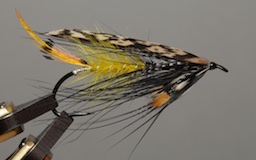Preserving the history is important: to ensure that historic events and data is available for future generations, and to make it easily available for anyone to share and consume. The history of classic fly patterns is one such thing that must be preserved for the future.
I started a few years back with a site called flyhooks.org: this came more out of the need to know why a #12 hook isn't a #12 hook across different brands, and when companies claimed a unique design, it just wasn't that.... The site quickly grew, and the importance to preserve old hooks was clear as I got hooks from all over the world to keep and add to the, now over 1000-hook picture large, index of hooks.
In 2017 I was invited to come to the ASFI in Canada to tie classic salmon patterns at one of the biggest events in the field. I was honoured, but also tried to look ahead at what I would present at the event. flyhooks.org was a given: I'll bring hooks, a photo book of classic salmon hooks and a nice slideshow where people can look at hooks in large resolution.
Around this time I started to focus more on classic salmon patterns for practical fishing, and the big classic tiers was researched: books bought, PDFs downloaded and google used frequently to find out something particular about a pattern. A lot has been written about the classic era of flytying, but I still had a tick (like the flyhooks.org annoyance about not finding information online about the topic) that I knew I had to do something about.
William Blacker is one author that have been highly influential to me the last year when it comes to patterns and the philosophy around flytying, but there was virtually no information online, and the few books that are available are not easy to get a hold of, or are very expensive to buy. At this time the idea with flypattern.org started growing: I've got the basic site setup already covered from flyhooks.org and flytyer.org, I have PDFs of the old books and I have a event in Canada 2018 to do something for.
flypattern.org is the site that I'm now launching, after working on and off for it since October 2017. The idea is to preserve the old patterns as they were written, a historical index of classic (both old and new classics - more about that later) where you can search and digg deep into the material about what the old patterns was all about. I have started with some of the classic authors where I could easily find the PDFs of books that could be indexed. Since the goal was to have something ready for the ASFI I have also focused on the salmon fly authors to start with, and I haven't covered all of them by a long shot! This is a work in progress, but I have now close to 500 patterns available to browse through, and the site is ready to be launched.

Then there is a "modern" interpretation of how we, today, are more used to seeing a pattern written down. Here the pattern is uniform across all books and authors. This is where there are most variations on how people write and share patterns, but worry not if you find that the pattern I've written is wrong or not how you would describe it: press the "Feedback" button on the right and send me a message about the pattern, and I'll update it, or we'll have a discussion on how it is.
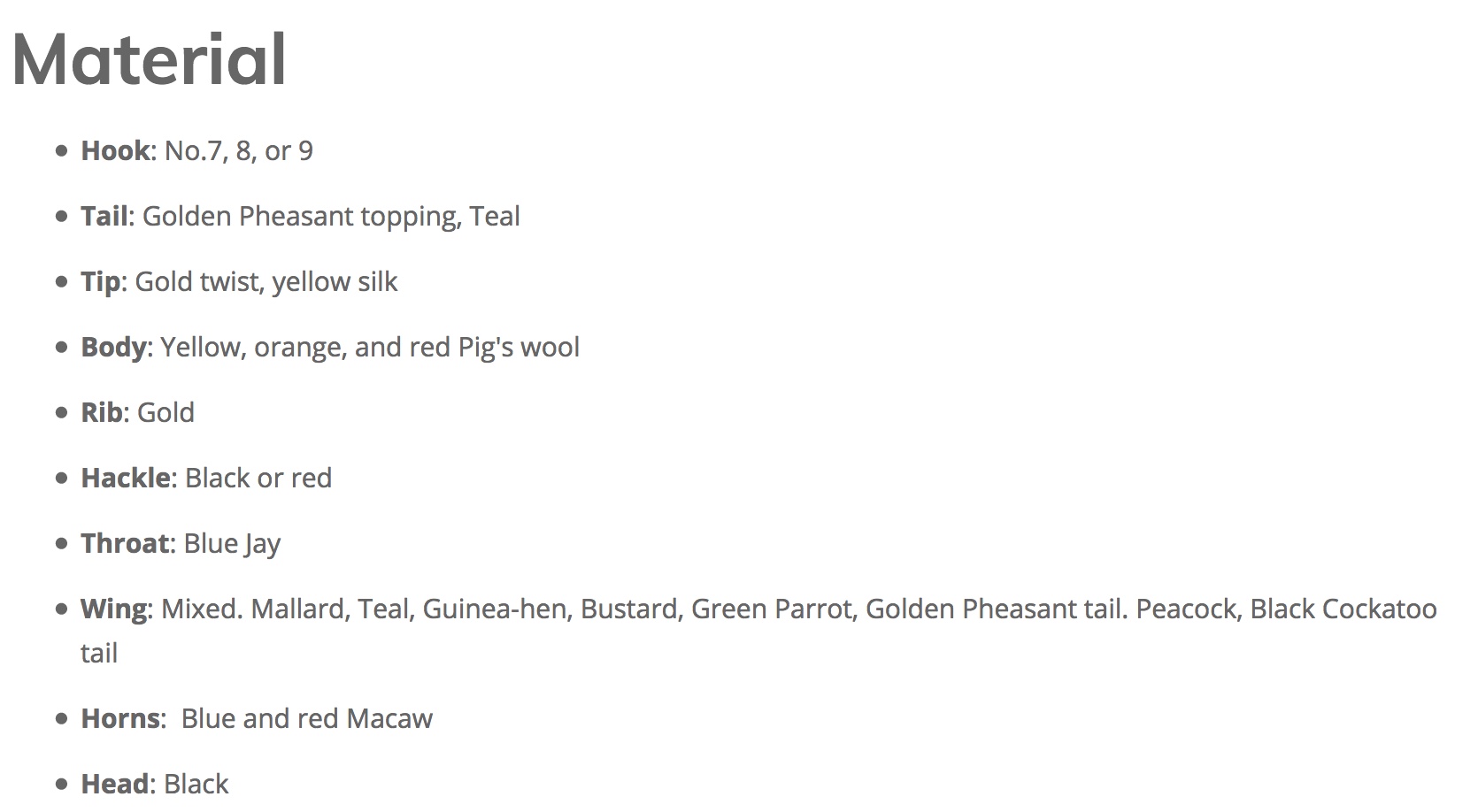
Each pattern have been broken down into its individual components. This means that each material have its own individual entry in the database, making it possible to search and browse with absolute certainty about what you are looking at is the same across authors. This is the bulk of the work going into this site: you can now search and ask questions like: "give me patterns by Blacker that have red swan in the wing, GP tippet in the tail and green seals fur in the body". Other sites normally do this by doing a text-search in the patterns, but here you will be able to define exactly what you are after, and get a correct answer.
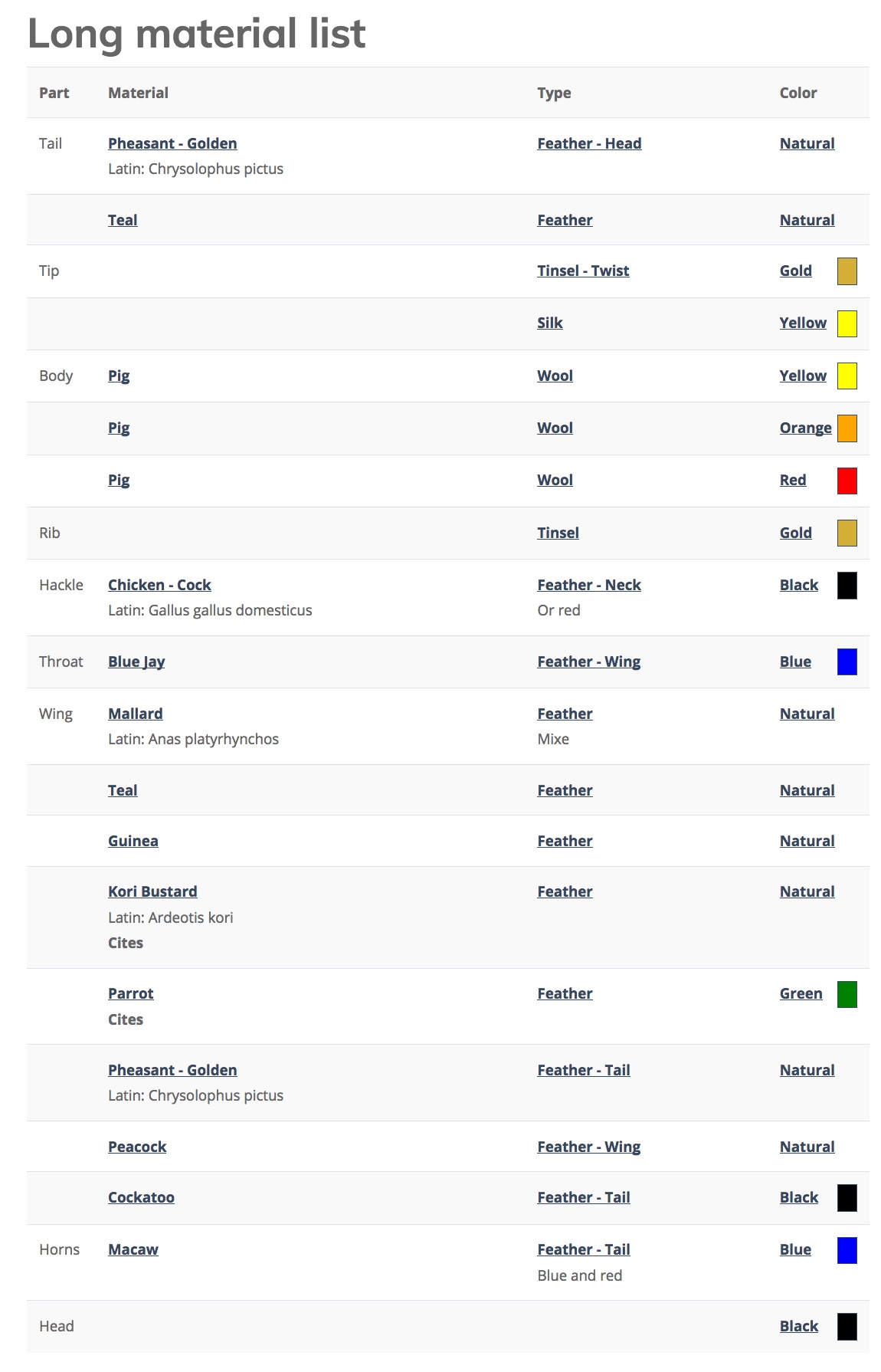
With the individual components available it is also possible to correctly identify the material used: at the bottom of each pattern you will be able to see macro shots of the main materials that have been collected. Here there is still some work to be done, but you will find all the base materials available.
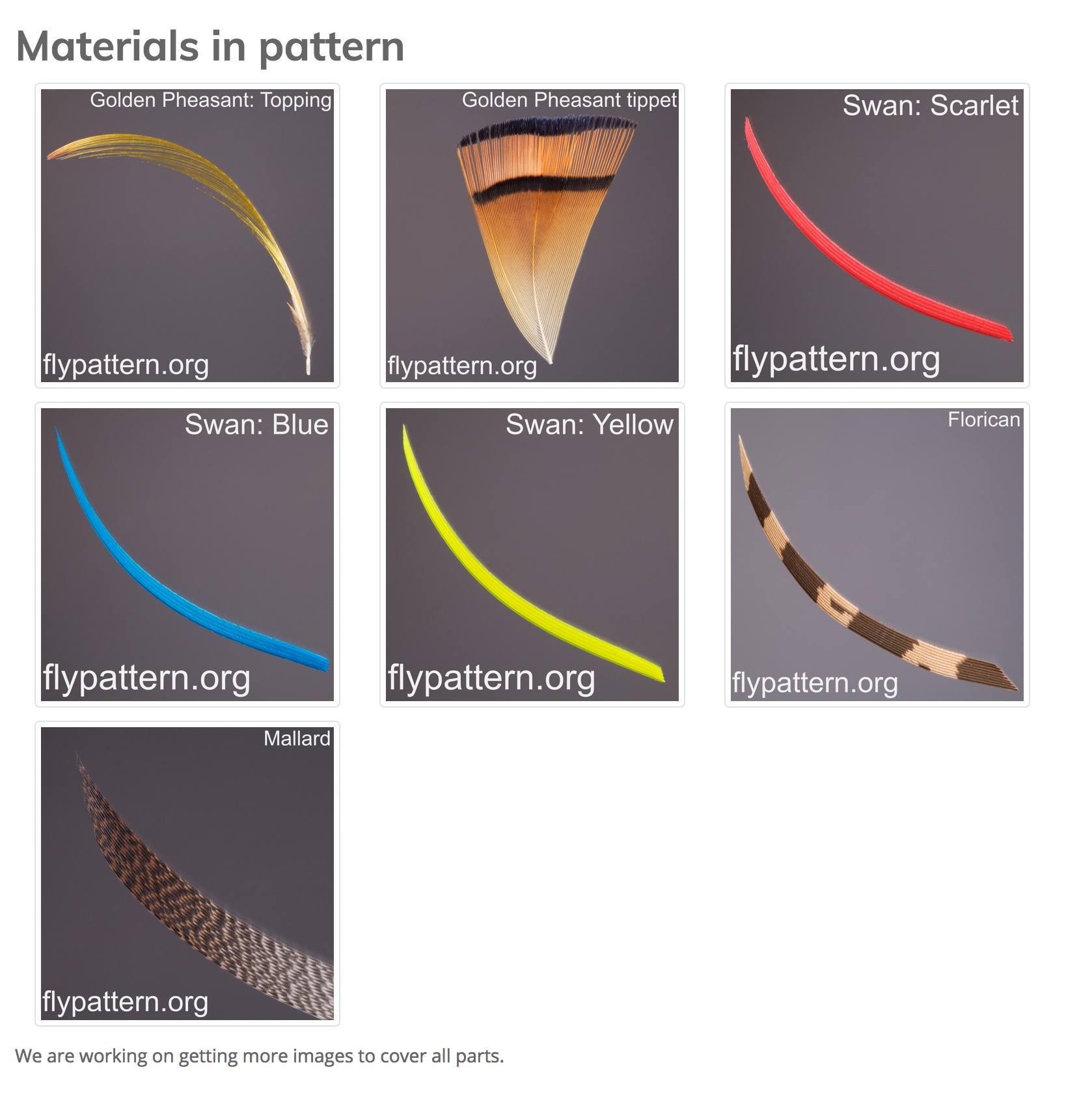
This index is also the basis for the insight information that you will find for authors and books:
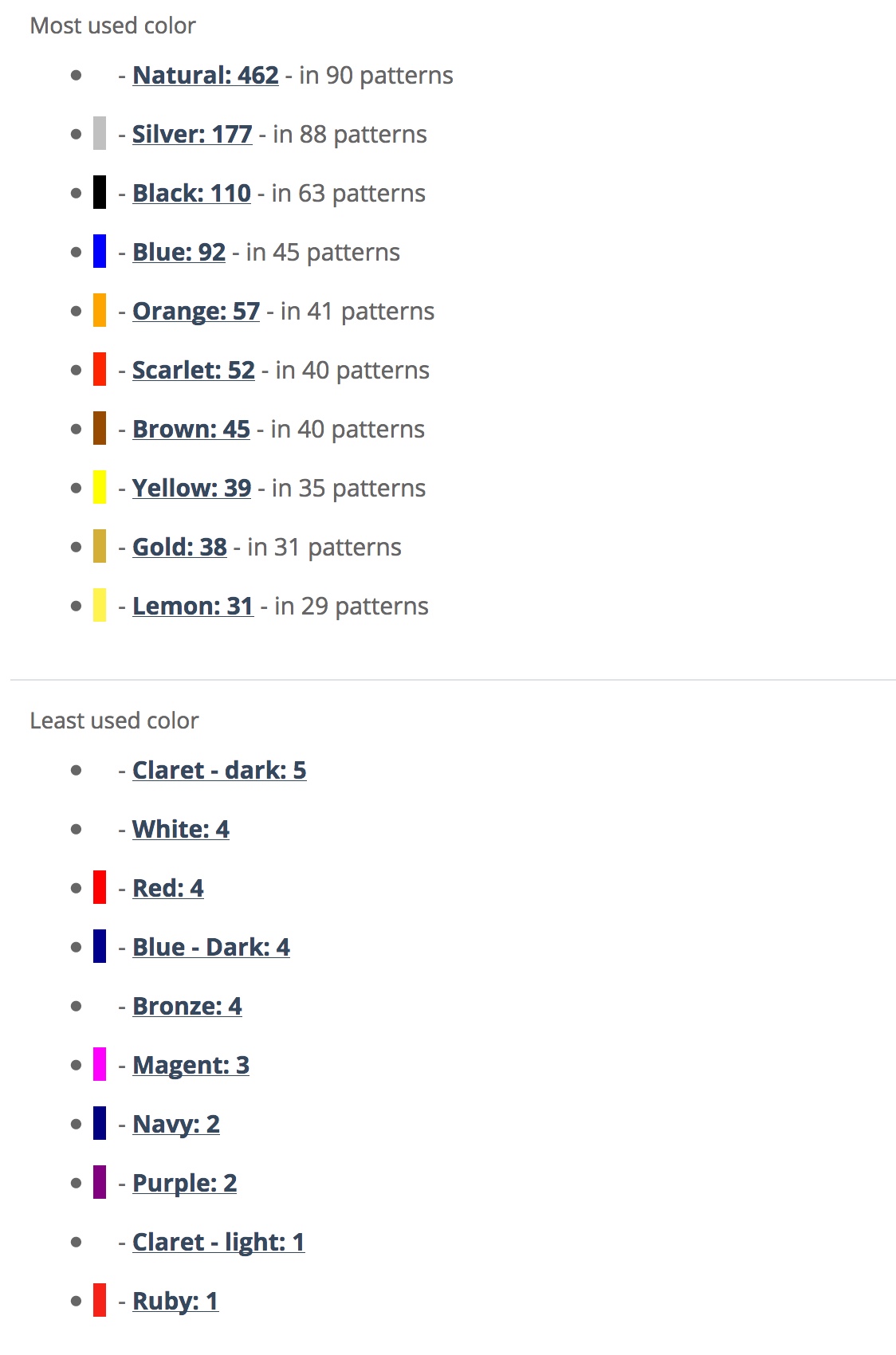
With all material properly index you can start searching for material and patterns This can be a starting point for material you have available, but don't know which pattern to do next: if you have yellow swan, wood duck and green seals fur: which patterns do you have a starting point for?
Here we are searching for:
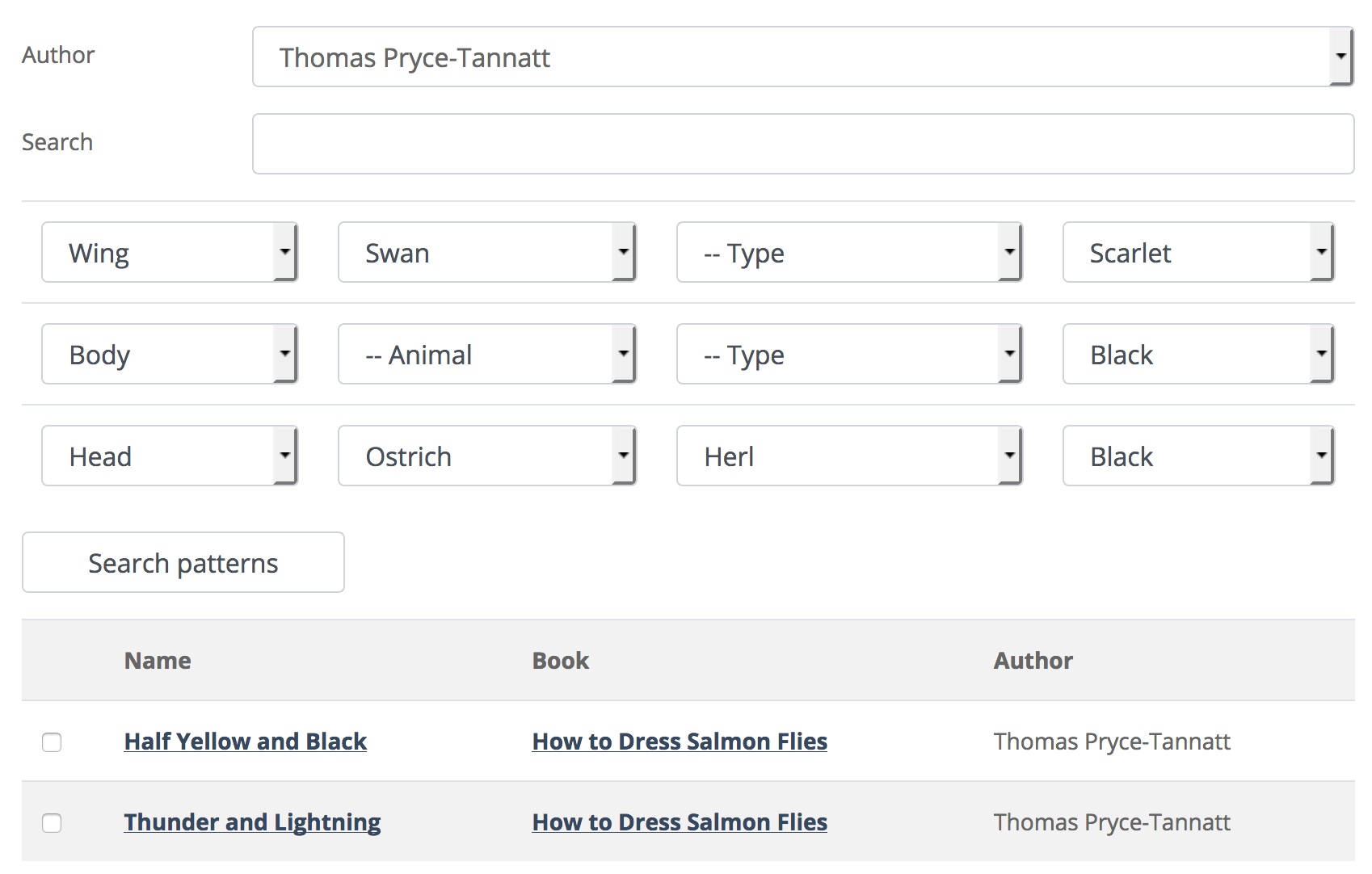
And we arrive with two patterns.
Each material have its own page, with a overview of different colour variations, and which patterns are using which colour of it. The images are also there for educational use to correctly identify the different materials that make up a fly.
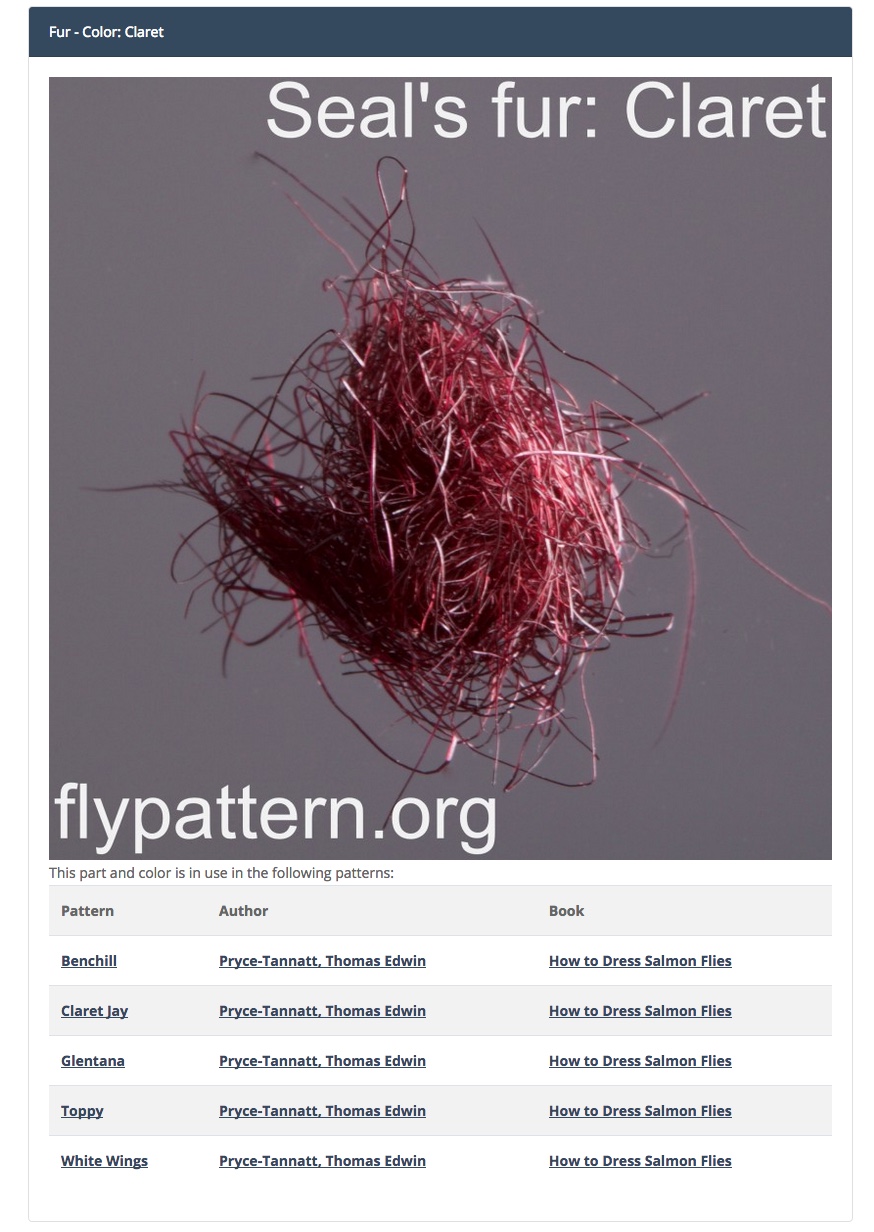
The work to tag material according to the CITES have started, and will be continued in the near future, but the idea is to have a overview and automatic substitute suggestions on each pattern, making it possible to do CITES-free variants of each pattern.
flypattern.org is not a classic-salmon site, this is important to repeat: the focus will now be to get more trout, char and other patterns added to the site with the same treatment as the classic salmon patterns have been given. Making it possible to search only on trout patterns that contain mohair and partridge. But more about that later.
The site is new and is now coming out to a beta phase, so if you find any errors or want to provide some feedback (good and bad): please contact me! The site is not perfect, and I'm the only one that have been adding content to it for now, so feedback is appreciated.
I hope this site can give information to the community, and that it will grow in the same way as flyhooks.org have been: by feedback and input from you!
Håvard Eide - 2018.05.27
I started a few years back with a site called flyhooks.org: this came more out of the need to know why a #12 hook isn't a #12 hook across different brands, and when companies claimed a unique design, it just wasn't that.... The site quickly grew, and the importance to preserve old hooks was clear as I got hooks from all over the world to keep and add to the, now over 1000-hook picture large, index of hooks.
In 2017 I was invited to come to the ASFI in Canada to tie classic salmon patterns at one of the biggest events in the field. I was honoured, but also tried to look ahead at what I would present at the event. flyhooks.org was a given: I'll bring hooks, a photo book of classic salmon hooks and a nice slideshow where people can look at hooks in large resolution.
Around this time I started to focus more on classic salmon patterns for practical fishing, and the big classic tiers was researched: books bought, PDFs downloaded and google used frequently to find out something particular about a pattern. A lot has been written about the classic era of flytying, but I still had a tick (like the flyhooks.org annoyance about not finding information online about the topic) that I knew I had to do something about.
William Blacker is one author that have been highly influential to me the last year when it comes to patterns and the philosophy around flytying, but there was virtually no information online, and the few books that are available are not easy to get a hold of, or are very expensive to buy. At this time the idea with flypattern.org started growing: I've got the basic site setup already covered from flyhooks.org and flytyer.org, I have PDFs of the old books and I have a event in Canada 2018 to do something for.
flypattern.org is the site that I'm now launching, after working on and off for it since October 2017. The idea is to preserve the old patterns as they were written, a historical index of classic (both old and new classics - more about that later) where you can search and digg deep into the material about what the old patterns was all about. I have started with some of the classic authors where I could easily find the PDFs of books that could be indexed. Since the goal was to have something ready for the ASFI I have also focused on the salmon fly authors to start with, and I haven't covered all of them by a long shot! This is a work in progress, but I have now close to 500 patterns available to browse through, and the site is ready to be launched.
Features
Each pattern have the original pattern recipe, as it was written by the author at the time of publishing. For me this was important to get down, and I have copied the original pattern word for word, even the formatting is as close as possible to how it was done. This is why it will look different from author to author, and book by book.
Then there is a "modern" interpretation of how we, today, are more used to seeing a pattern written down. Here the pattern is uniform across all books and authors. This is where there are most variations on how people write and share patterns, but worry not if you find that the pattern I've written is wrong or not how you would describe it: press the "Feedback" button on the right and send me a message about the pattern, and I'll update it, or we'll have a discussion on how it is.

Each pattern have been broken down into its individual components. This means that each material have its own individual entry in the database, making it possible to search and browse with absolute certainty about what you are looking at is the same across authors. This is the bulk of the work going into this site: you can now search and ask questions like: "give me patterns by Blacker that have red swan in the wing, GP tippet in the tail and green seals fur in the body". Other sites normally do this by doing a text-search in the patterns, but here you will be able to define exactly what you are after, and get a correct answer.

With the individual components available it is also possible to correctly identify the material used: at the bottom of each pattern you will be able to see macro shots of the main materials that have been collected. Here there is still some work to be done, but you will find all the base materials available.

This index is also the basis for the insight information that you will find for authors and books:

With all material properly index you can start searching for material and patterns This can be a starting point for material you have available, but don't know which pattern to do next: if you have yellow swan, wood duck and green seals fur: which patterns do you have a starting point for?
Here we are searching for:
- A Pryce-Tannatt pattern
- That uses scarlet swan in the wing
- That have something black in the body
- That have a black herl head

And we arrive with two patterns.
Each material have its own page, with a overview of different colour variations, and which patterns are using which colour of it. The images are also there for educational use to correctly identify the different materials that make up a fly.

The work to tag material according to the CITES have started, and will be continued in the near future, but the idea is to have a overview and automatic substitute suggestions on each pattern, making it possible to do CITES-free variants of each pattern.
flypattern.org is not a classic-salmon site, this is important to repeat: the focus will now be to get more trout, char and other patterns added to the site with the same treatment as the classic salmon patterns have been given. Making it possible to search only on trout patterns that contain mohair and partridge. But more about that later.
The site is new and is now coming out to a beta phase, so if you find any errors or want to provide some feedback (good and bad): please contact me! The site is not perfect, and I'm the only one that have been adding content to it for now, so feedback is appreciated.
I hope this site can give information to the community, and that it will grow in the same way as flyhooks.org have been: by feedback and input from you!
Håvard Eide - 2018.05.27
